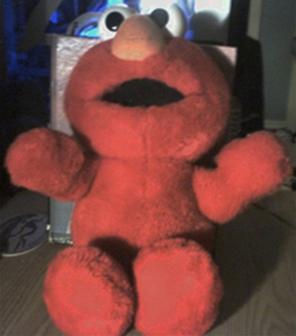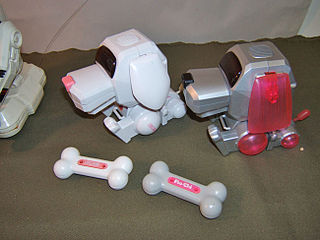Digimon, short for "Digital Monsters", is a Japanese media franchise, which encompasses virtual pet toys, anime, manga, video games, films, and a trading card game. The franchise focuses on the eponymous creatures that inhabit a "Digital World", which is a parallel universe that originated from Earth's various communication networks.

The Game.com is a fifth-generation handheld game console released by Tiger Electronics on September 12, 1997. A smaller version, the Game.com Pocket Pro, was released in mid-1999. The first version of the Game.com can be connected to a 14.4 kbit/s modem for Internet connectivity, hence its name referencing the top level domain .com. It was the first video game console to include a touchscreen and the first handheld console to include Internet connectivity.
Furby is an American electronic robotic toy by Tiger Electronics. Originally released in 1998, it resembles a hamster or owl-like creature and went through a period of being a "must-have" toy following its holiday season launch. Over 40 million Furbies were sold during the three years of its original production, with 1.8 million sold in 1998, and 14 million in 1999. Its speaking capabilities were translated into 14 languages.

A virtual pet is a type of artificial human companion. They are usually kept for companionship or enjoyment, or as an alternative to a real pet.
Tiger Electronics Ltd. is an American toy manufacturer best known for its handheld electronic games, the Furby, the Talkboy, Giga Pets, the 2-XL robot, and audio games such as Brain Warp and the Brain Shift. When it was an independent company, Tiger Electronics Inc., its headquarters were in Vernon Hills, Illinois. It has been a subsidiary of Hasbro since 1998.

Tamagotchi is a brand of handheld digital pets that was created in Japan by Akihiro Yokoi of WiZ and Aki Maita of Bandai. It was released by Bandai on November 23, 1996 in Japan and in the United States on May 1, 1997, quickly becoming one of the biggest toy fads of the late 1990s and the early 2000s. As of June 2023, over 91 million units have been sold worldwide. Most Tamagotchi are housed in a small egg-shaped handheld video game with an interface consisting of three buttons, with the Tamagotchi Pix adding a shutter on the top to activate the camera.

Simon is an electronic game of short-term memory skill invented by Ralph H. Baer and Howard J. Morrison, working for toy design firm Marvin Glass and Associates, with software programming by Lenny Cope. The device creates a series of tones and lights and requires a user to repeat the sequence. If the user succeeds, the series becomes progressively longer and more complex. Once the user fails or the time limit runs out, the game is over. The original version was manufactured and distributed by Milton Bradley and later by Hasbro after it took over Milton Bradley. Much of the assembly language code was written by Charles Kapps, who taught computer science at Temple University and also wrote one of the first books on the theory of computer programming. Simon was launched in 1978 at Studio 54 in New York City and was an immediate success, becoming a pop culture symbol of the 1970s and 1980s.

Tickle Me Elmo is a children's plush toy from Tyco Preschool, a division of Tyco Toys, of the Muppet character Elmo from the children's television show Sesame Street. When squeezed, Elmo recites his trademark giggle. When squeezed three times, Elmo shakes and vibrates.

An electronic game is a game that uses electronics to create an interactive system with which a player can play. Video games are the most common form today, and for this reason the two terms are often used interchangeably. There are other common forms of electronic games, including handheld electronic games, standalone arcade game systems, and exclusively non-visual products.

Tomy Company, Ltd. is a Japanese toy company. It was established in 1924 by Eiichirō Tomiyama as Tomiyama Toy Manufacturing Company (富山玩具製作所), became known for creating popular toys like the B-29 friction toy and luck-based game Pop-up Pirate. In 2006, Tomy merged with another toy manufacturer, Takara, and although the English company name remained the same, it became Takara Tomy in Asia. It has its headquarters in Katsushika, Tokyo.

Poo-Chi, one of the first generations of robopet toys, is a robot dog designed by Samuel James Lloyd and Matt Lucas, manufactured by Sega Toys, and distributed by Tiger Toys. Poo-Chi was released in 2000 and discontinued in 2002.

The Digital MonsterJPN is a digital pet created by WiZ and Bandai that spawned the Digimon franchise. It was released by Bandai on June 26, 1997, in Japan and on December 5, 1997 in North America. This pet was a masculine counterpart to the Tamagotchi, which was deemed more appropriate for girls. It was similar to earlier virtual pets with the distinctions of being a fighting pet that could connect with others like it.
Diva Starz was a series of talking fashion dolls created and released by Mattel in October 2000. They are similar in design to MGA's Bratz and Tiger Electronics' Furby. Alexa, Nikki, Summer—later replaced by Miranda—and Tia were offered in the original debut. Originally produced as robotic dolls, Mattel would also release miniature and fashion doll versions in response to their initial success. The line was discontinued in 2004.

Talkboy is a line of handheld voice recorder and sound novelty toys manufactured by Tiger Electronics in the 1990s. The brand began as a result of a promotional tie-in with the 1992 film Home Alone 2: Lost in New York; the most well-known product was the Deluxe Talkboy, a cassette recorder and player with a variable-speed voice changer that caused toy crazes over several holiday shopping seasons beginning in 1993.

FurReal Friends is a toy brand division of Hasbro and formerly of Tiger Electronics and Dreamright Toys created in 2002 focusing on robotic pets. FurReal toys widely vary in style and size, depicting different domesticated animals, wild animals, and legendary creatures as robotic toys. They are usually small enough to be held, but have been manufactured large enough for children to sit on. Each furReal robotic toy moves to a degree.
Zizzle was a company based in Bannockburn, Illinois, United States, that made many types of electronics and toys based on original concepts as well as movie licenses. They are best known for a toy called "iZ".
The Tamagotchi effect is the development of emotional attachment with machines, robots or software agents. It has been noticed that humans tend to attach emotionally to inanimate objects devoid of emotions of their own. For example, there are instances when people feel emotional about using their car keys, or with virtual pets. It is more prominent in applications which simulate or reflect some aspects of human behavior or characteristics, especially levels of artificial intelligence and automated knowledge processing.

Brain Warp is an electronic audio game which prototypes were invented by Big Monster Toys, and its final game production was manufactured and published by Tiger Electronics and released on June 16, 1996. In this game, players follow the spoken instructions from sound files spoken from the game unit. The player has to rotate the game in different directions so that the correct color is facing upwards. Its catchphrase which the voice says before a game begins is: "If you don't keep up with me, you're finished!". When you fail a game, the game unit will say "this game is finished" and then it will say "wanna warp again?". A Star Wars version titled Death Star Escape was released by Tiger Electronics in 1997 and the games are called Challenges.

The WonderBorg is a programmable consumer robot kit first released for the Bandai WonderSwan and Microsoft Windows PCs in 2000. It is intended to match both the external appearance and mode of transport of a beetle, with functioning antennae and a six-legged design.

Tekno the Robotic Puppy is a popular electronic robotic toy which originally launched in late 2000. Tekno sold more than 7 million units in its first season and went on to sell more than 40 million units in its original 4 years of production. The worldwide popularity for Tekno led to prominent awards and widespread media coverage which included newspaper articles, television and film appearances, and a stand-alone feature on the cover of Time magazine.













